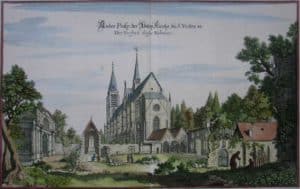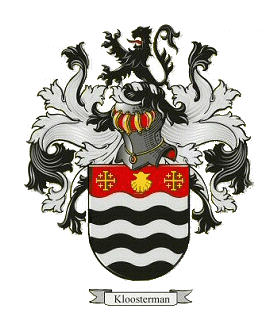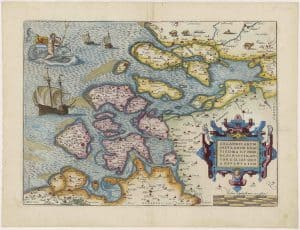See also:
Dutch emigrants
Introduction
History of the Kloosterman name and family
 The history begins in France, with the patronage of King Louis VI the Fat, the canons regular built c. 1113 the monastery of St.-Victor in Paris. St. Bernard of Clairvaux helped to shape the rule by which the monks lived, and Bernard, Becket, and Abelard were, at various times, guests of the monastery with great intellectual influence.
The history begins in France, with the patronage of King Louis VI the Fat, the canons regular built c. 1113 the monastery of St.-Victor in Paris. St. Bernard of Clairvaux helped to shape the rule by which the monks lived, and Bernard, Becket, and Abelard were, at various times, guests of the monastery with great intellectual influence.
The Victorines were a small order, but the monastery had many students, and in the XIII Century, it became a college within the University of Paris. In the following century, the monastery began to decline, and in the XV Century, the monks joined the Brethern of the Common Life, founded in Holland.
According to legend, Victor was a soldier in the Roman army at Marseilles when he was hailed before the prefects, Asterius and Eutychius, who sent him to Emperor Maximian for his exhortations to Christians to be firm in their faith in the face of an impending visit by the Emperor.
He was dragged through the streets, racked, imprisoned (he converted three guards, Alexander, Felician, and Longinus while in prison). He was again tortured after the guards were beheaded when it was discovered he had converted them to Christianity.
When he refused to offer incense to Jupiter, he was crushed in a millstone and beheaded. His tomb became one of the most popular pilgrimage centers in Gaul. His feast day is July 21st.
The abbey had a rich library open to the public. In the consulting room the manuscripts were chained. But there were other properties: liturgical manuscripts were kept for the choir, some others near the refectory, for reading aloud in the infirmary to the sick and dying, and others consisting of double reserves by the librarian (armarius). Part of the library consisted of a group of books (minores) the canons or students could borrow over long periods (concessi).
The teaching of the abbey activity favoured the development of library funds. Richly endowed, the abbey would be filled by purchases or copies from elsewhere: the scriptorium seems not to have been well developed. Endowments also enriched the collection. In addition, the documents found upon the death of a Victorin (sermons, for example) were compiled and stored in the library.
From this order of St.-Victor in 1246 Wolfaard van Maelstede founded the nunnery “Jerusalem” in Biezelinge in the south-west region of Holland (Zeeland) on four parcels of land. A lot of royalty contributed to the nunnery with gifts and legations. a few of them are known: the catholic king Willem II, Floris the Guardian, Floris V, Jan I, countess Aleida, count Willem III, the duke Aelbrecht and emperor Karel V. But the most important guardians remained the lords of Maelstede.
There were 15 to 20 nuns living in the monastery, in the sixteenth century only 6 to 8. The sisters belonged to the nobility from the region: ‘decent’ nuns. Their noble pride was evident from several incidents. There was even manslaughter in the church; around 1500, strangers stayed overnight in the monastery and the sisters went to the fair and to the wedding. They also listened poorly to the prioress, their superior.
The monastery had great say in Schore. It exercised patronage right there: the right to determine the patron saint of the church and to nominate a pastor for appointment. The latter is also called collation right. In 1266 Jerusalem bought land near Schore from the Antwerp Cistercian abbey Sint-Bernhard, which had a monastery farm here. The purchase strengthened the local influence of the Biezelingen monastery.
Gradually, the “Lady’s Monastery” Jerusalem fell into disrepair. In 1572 it was probably partly destroyed by itinerant Geuzen. According to legend, the sisters then fled through ‘subterranean passages’ to castle Poucques in Kapelle. The end came with the official introduction of Protestantism in 1578.
The remaining sisters lived for a while in Ostend Castle in Goes. About 1609, when the Twelve Years’ Truce with Spain began, the last prioress left for Antwerp. She took the monastery archives with her.
- Take a look at the Foundation charter of the Jerusalem cloister
(original SA Antwerpen, Belgium, K122)
1246 mei 21
feria secunda ante
Vrbani pape
schenkt 25 gemeten land gelegen
tussen de heerweg van Byzelinge
naar Vlaka in het zuiden, de waterloop
genaamd Muluht in het oosten; de weg
van Maelstede naar Sparth in het noorden
en de weg van Maelstede naar Byzelinge
in het westen, aan het nonnenklooster
van de orde van Sint Victor, genaamd
Jerusalem, gesticht in zijn ambacht op
bedoeld land, vrij van schot en
korentiend en van de afdracht van
voedingsmiddelen.
1246 mei 21
feria secunda ante
Vrbani pape
Wulfardus, lord of the Maelstede,
gives 25 acres of land between
the high road of Byzelinge to Vlaka
in the south, the watercourse named Muluht
in the east; the road from Maelstede
to Sparth in the north and the road
from Maelstede to Byzelinge in the west,
to the nunnery of the order of Sint Victor,
named Jerusalem, founded on his manor and
named lands, free of taxes and corn tithe and
free of the obligation to provide food.
How the cloister really looked, nobody knows. but there is a picture, dated 1546 (picture right) and it is included in a description of Zeeland by Andries Schoenmaker, it says:
“Het was een groot gebouw met flinken toren en omringd door een hoogen muur, waaromheen een vest of gracht.”
“Is was a big building with a rather great tower, surrounded by a high wall and a moat or canal”
During 16th-century iconoclastic fury, in 1572 the nunnery was destroyed, probably by the Geuzen “Dutch protestant rebels” under command of Jerome Seraerts. Four Victorine nuns survived the slaugther and took refuge somewhere else.
They returned in 1578, but the prioress Cathelina Meskens after receiving permission from her Vicar-General sold the remnants. The remaining buildings were demolished in the seventeenth century, the site remained known as the Klooster and the Kloosterhoek (between the railway and the Dankerseweg). In 1703, the moat still existed, because it is said that the widow Orliens owned several parcelsf land that were along the canal.
After this the land was leased out.
Those four parcels where called “het clooster” (the cloister).
Cloosterman or Kloosterman
literally means in English:
“man from the cloister”
The first name in the Kloosterman history appears around 1550, in the name of Claes and his son Jan Claesz. Claes lived and worked those four parcels of land around 1550 – 1580 in Kapelle Biezelinge. In 1583 this was the place where Jan Claesz. lived and in 1618 Cornelis Jansz. op ‘t Clooster (“Jansz.” short for Janszoon, meaning son of Jan and “op ‘t”, meaning: on the). This “Op ‘t Clooster” can be taken literally, because in an account of Floris van Schaek (1579) the name Jan Claesz comes up as:
“wonende op de stede van ‘t voorzeide clooster”
which means: “living on the farm, frontside of the Cloister”
In the neighbourhood of the Cloister there was probably a farm. His descendants (although they did not rented land) were known as Cloosterman and later Kloosterman (around 1750).
During the 16th and 17th-century the land where the nunnery once was, kept called:
Den Houck daer ‘t Clooster in staet”
This means more or less: “The Land Where The Cloister is”.
Later it was called “Cloosterland” and because ofthis name, the people living on it where called Cloosterman. The name of the land (Kloosterland) disappeared in 1625 but the family nameKloosterman was founded by that time.
Even today the land where the cloister once was, is still easy to locate. In the ground you will still find the stones where the nunnery was build from. These stones are recognised by their colour and surface. The stones have a green glaze surface. There where more nunneries(cloisters) in Holland due to which families are named Kloosterman today. ou don’t necessarily have to have your roots in the region Zeeland if your name is Kloosterman. At the location in Zeeland you will still find a farm with the name “Kloosterhoeve”.
This farm was occupied by the Kloosterman family for longer times though not constantly.



